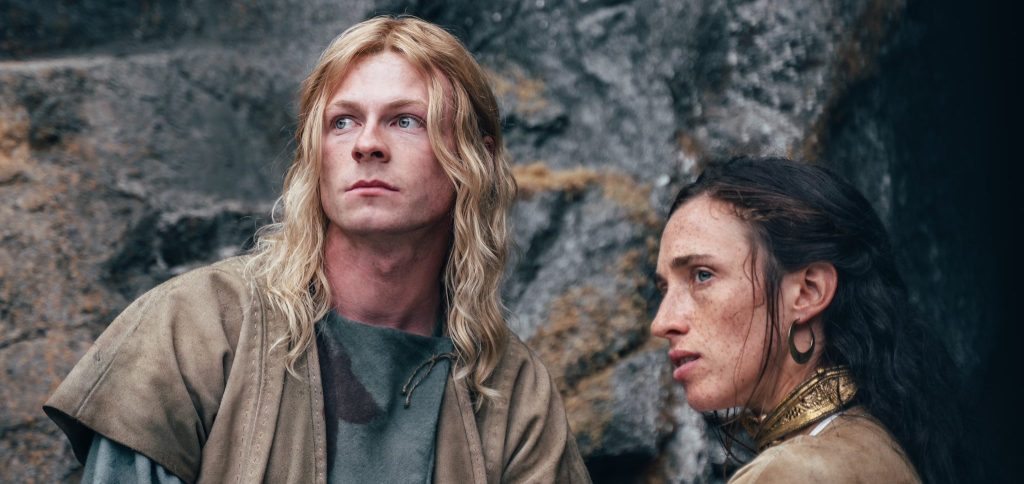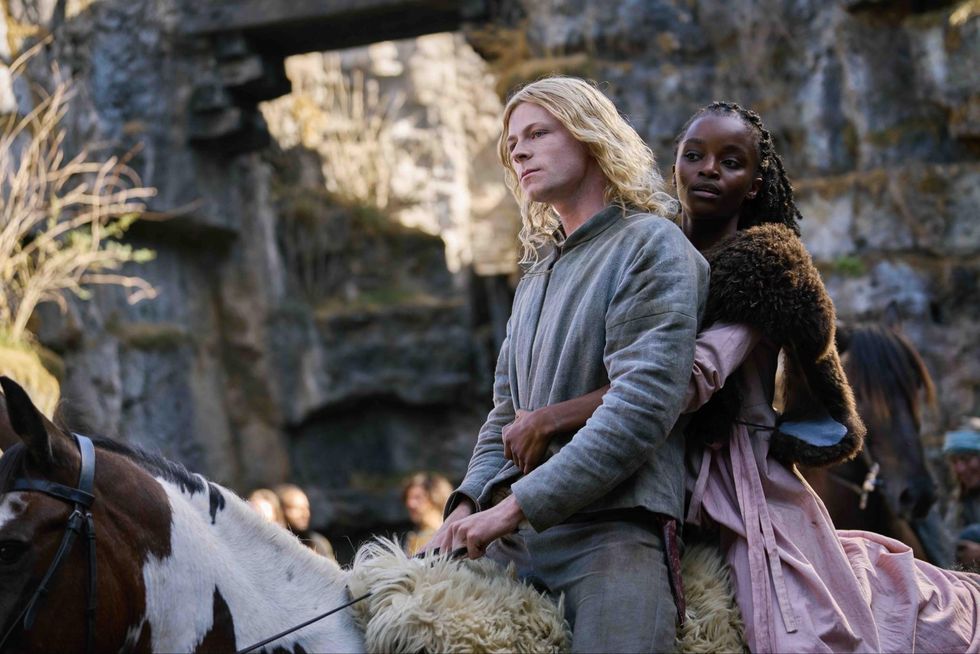Created by Kate Brooke, Ed Whitmore, and Bernard Cornwell, MGM+’s ‘The Winter King’ is a historical fantasy drama show that is set in a brutal and chaotic fifth-century Britain, where warring factions and tribes vie for control. In this time of uncertainty, Arthur Pendragon rises from an outcast to a legendary warrior and leader. The story is told by Arthur’s former sworn warrior, Derfel, who reiterates very early in the story that Arthur was banished to Armorica by his father. He returns to the kingdom to safeguard his newborn nephew, Modred, who is now the reigning monarch.
On the other hand, Britain is on the verge of being united and at peace, but Arthur’s return and his consecutive decision to marry Guinevere plummets the island into war again. This big-budget television phenomenon stars Iain De Caestecker as the legendary Arthur and Jordan Alexandra as Guinevere, a woman seeking more power and position for herself. The cast also comprises Stuart Campbell (Derfel Cadarn), Ellie James (Nimue, the priestess), and Eddie Marson (Arthur’s father, Uther). The vast production design, realistic performances of the impressive cast, and the taut storyline must make you wonder whether the show is based on a true story. Let’s delve in and find out, shall we?
The Winter King: Legendary Tale, Not History
‘The Winter King’ is not based on a true story. It is an adaptation of the ‘The Warlord Chronicles’ trilogy written by Bernard Cornwell, which is a fictional account of the Arthurian legends. The book series was originally published between 1995 and 1997 and was very well-received. To explain it further, the Arthurian legend is a body of stories and myths about King Arthur, a legendary British leader who may have lived in the fifth or sixth century. The stories have been told and retold for ages, but there is no single, definitive version of the legend. The trilogy condensed the legends into a story and assorted them with fabled tales.

Among the numerous versions of the Arthurian legends that exist, ‘The Warlord Chronicles’ is considered to be quite realistic. Over the years, the books have collected accolades for depicting the socio-political fabric of Romano-British society in a very authentic manner. They have also been successful in painting characters in a far more complex light which makes them more believable than their preceding representation in popular culture.
As far as the story of ‘The Winter King’ is concerned, it succulently blends historical events with fictional drama and anecdotes. The Battle of Badon Hill discussed in the book is backed by many anthropological studies and research. Similarly, reports suggest that the weapons and tactics used in the war, as depicted in the show, are historically accurate and give us a glimpse into the technical advancements of the time. Similarly, the Celtic religion and its mythology is a prominent theme of the story and it is precisely used to exhibit the influence of the aforementioned beliefs on people’s psyche and discourse during the time.
The overarching plot of the show is a truthful representation of the political landscape of the time. Britain was divided into small kingdoms and their struggle against the Saxons is a very significant part of mainstream history. The story has been written after an exhaustive study of fifth-century Britain and is even considered to be a credible historic resource by many readers. Since the show is based on books and Bernard Cromwell himself is one of the creators, we can be assured that these accuracies will be sustained and not compromised.
In a 2007 interview with the University of Rochester, when Cromwell was asked about the resources he used for his books, he said, “I read everything I could. A huge amount of archaeology; whatever I could find in post-Roman Britain was academically respectable. You then plunge into the extremely murky pool of Arthurian dictionaries of Celtic Britain, the mystical stuff. What was really interesting, though, was to read the lives of Saint Padarn, Saint Carannog, and others; and I then went on to things like the Laws of Hywel Dda. I read a lot of Old Welsh material because although this is much later than the Arthurian period, I have a belief that these things hang on.”
The story does extend its tenets beyond Arthurian legends and has characters that are completely a figment of Cromwell’s imagination. While characters like Durfel Cadarn and Uther Pendragon cannot be backed by any chronicled tale, other characters, like the pagan mystic Merlin, are very obviously a manifestation of British lore. It is important to remember that tales of the Dark Ages often fill in gaps in the historical record with imagination and speculation. Works such as ‘The Warlord Chronicles’ play a very significant part in recreating history to reinforce them in public memory.
Even though the Arthurian legends have been brought back to life numerous times, especially in the last few decades, ‘The Winter King’ mostly delivers on fronts such as verifiability, performance, visuals, and magnanimity and gives us a peek into the social upheaval of the times. In conclusion, the historical fantasy nature of the show leaves it to its viewer’s discretion to deduce reality from the parables of the show.
Read More: Best Historical Dramas on Netflix


You must be logged in to post a comment.